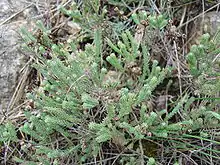| Hypericum ericoides | |
|---|---|
 | |
| Scientific classification | |
| Kingdom: | Plantae |
| Clade: | Tracheophytes |
| Clade: | Angiosperms |
| Clade: | Eudicots |
| Clade: | Rosids |
| Order: | Malpighiales |
| Family: | Hypericaceae |
| Genus: | Hypericum |
| Section: | Hypericum sect. Coridium |
| Species: | H. ericoides |
| Binomial name | |
| Hypericum ericoides | |
Hypericum ericoides is a dwarf shrub in the flowering plant family Hypericaceae,[1] section Coridium. It is found in eastern and southeastern Spain, Morocco, and Tunisia. Its preferred habitat is fissures in calcareous rocks in warm, sunny places, from 200 to 2,000 meters above sea level (MASL).
Description
Hypericum ericoides is an evergreen flowering dwarf shrub whose height is between 2 and 20 centimeters. Its deciduous leaves are whorled in groups of four, are about one-twelfth of an inch long, and have linear-lancolate and recurved shape with a thin, waxy-grey colored covering, which is called a patina.[2] Its leaves are very much like that of plants from the genus Erica, which is where we get the ericoides of Hypericum ericoides. This species' foliage helps scientists distinguish H. ericoides from other closely related species.[3] It has many thin, erect stems, ranging from 1 to 5 millimeters in width, branching out from a stout, woody base.[2]
Its flowers, which start to bloom in May and continue to bloom throughout summer,[4] range from one to one and a half centimeters in diameter, are often yellow in color, and have five petals.
Medicinal use
Hypericum ericoides has been used for many years in Valentian folk medicine.[5] Interested by this, the species has been studied for its health benefits, not only because of its use in folk medicine but also for scientific reasons. Some of these include its antiglycation, antioxidation, anti-lipid peroxidation and cytotoxic activities.[6] Studies have shown that the species can be used to dissolve kidney stones, improve blood circulation, and increase appetite.[7]
In addition, H. ericoides has a fairly low fatty acid composition in comparison to several other members of its genus.[8] It also contains some xanthone compounds.[9]
Subspecies
There are several unofficial subspecies of Hypericum ericoides, including H. ericoides ericoides, H. ericoides roberti, and H. ericoides marrocanum. As these are widely considered by the scientific community synonymous with H. ericoides, and show no distinct difference with the species, these are not officially accepted subspecies.[10]
References
- ↑ Abbas, G; Shahzad, M; Saddiqe, Z; Hassan, MJ; Saba, S; Rafique, J; Malik, R; Hussain, H (May 2015). "Various fractions of Hypericum x moserianum and Hypericum ericoides possess antiglycation, anti-lipid peroxidation, antioxidative activities and non-toxic effects in vitro". Pak J Pharm Sci. 28 (3): 933–8. PMID 26004727.
- 1 2 "Nomenclature | Hypericum online". hypericum.myspecies.info. Retrieved 2015-10-08.
- ↑ "Bean's Trees and Shrubs". www.beanstreesandshrubs.org. Retrieved 2015-10-15.
- ↑ "Bean's Trees and Shrubs". www.beanstreesandshrubs.org. Retrieved 2016-03-30.
- ↑ Cardona, M. Luz; Seoane, Eliseo (1982-03-01). "Xanthone Constituents of Hypericum ericoides". Journal of Natural Products. 45 (2): 134–136. doi:10.1021/np50020a004. ISSN 0163-3864.
- ↑ Abbas, Ghulam; Shahzad, Muhammad; Saddiqe, Zeb; Hassan, M. Jawad; Saba, Sumbal; Rafique, Jamal; Malik, Rizwana; Hussain, Hidayat (2015-05-01). "Various fractions of Hypericum x moserianum and Hypericum ericoides possess antiglycation, anti-lipid peroxidation, antioxidative activities and non-toxic effects in vitro". Pakistan Journal of Pharmaceutical Sciences. 28 (3): 933–938. ISSN 1011-601X. PMID 26004727.
- ↑ "Hypericum ericoides" (PDF). Archived from the original (PDF) on 2008-08-28. Retrieved 2015-10-08.
- ↑ Hosni, Karim; Msaâda, Kamel; Taârit, Mouna Ben; Marzouk, Brahim (2017). "Fatty acid composition and tocopherol content in four Tunisian Hypericum species: Hypericum perforatum, Hypericum tomentosum, Hypericum perfoliatum and Hypericum ericoides Ssp. Roberti". Arabian Journal of Chemistry. 10: S2736–S2741. doi:10.1016/j.arabjc.2013.10.019.
- ↑ Cardona, M. Luz; Seoane, Eliseo (1982). "Xanthone Constituents of Hypericum ericoides". Journal of Natural Products. 45 (2): 134–136. doi:10.1021/np50020a004.
- ↑ "Nomenclature | Hypericum online". hypericum.myspecies.info. Retrieved 2015-10-15.